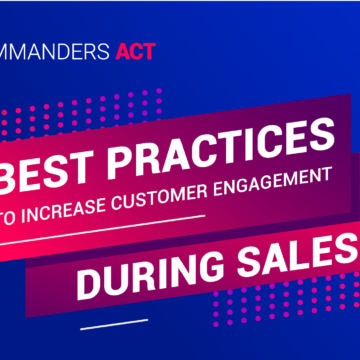What if you removed all the cookies from your website? Lessons from Sentry’s Journey
05/02/2024 |

Removing cookies from a website sounds like the worst case scenario for marketers. However, that is what is really coming ahead. So, why not prepare yourself now ?
In a bold move, the code monitoring platform Sentry switched off all cookies and user tracking from its website in July 2023, in a move to anticipate the impending industry shift towards a cookieless future. As they explained, this decision was “driven by a commitment to privacy and aligning with user expectations” and has brought about challenges and unexpected benefits.
What lessons have sentry learned about this experience is the output of the article cited below.
Why did we choose to talk about Sentry’s experience?
Involved in marketing & customer data collection, Commanders Act has long anticipated the big industry shift towards increased privacy and harder visitor identification.
Sentry’s experience is interesting as – to our knowledge – few advertisers have had the “gut” to perform a controlled live test to analyse the impacts. Therefore we think that it’s worth summarising this experience and sharing it to our network.
Congrats Sentry 👏.
What your need to remember about Sentry’s cookie removal experience ?
Why did they choose to remove cookies?
- People are becoming privacy-conscious and do not want companies misusing their data. They tend to refuse all cookies anyways.
- As Chrome will remove third-party cookies in 2024, we better get prepared to learning how to use cookieless tools
- It’s a way to create trust with your audience and built a strong relationship
Overall this move was analysed as a good idea, it seemed important for Sentry marketing team to understand what was the impact on marketing actions.
Unexpected difficulties
Even though Sentry anticipated an effect on attribution models, marketing reports, Google Analytics, and various other tracking. Unexpected issues came into light, such as
- YouTube video embeds on their site (used cookies and therefore not displayed anymore as far as we understand)
- Their bot blocking tool for ads was stopped as it was relying on pixel and GCLID to split human & bots
- Overall losing performance tracking signals used by ad platforms to identify conversions. We share Sentry’s opinion that this can be tricky for companies relying on digital marketing for their growth.
How to keep performing without cookies?
Four major pilars are cited as necessary to navigate in a cookieless world.
- Targeting – Focus on middle & bottom funnel: Sentry adopted ad engagement retargeting across most channels, providing an imperfect but useful workaround for the broken retargeting effort. This approach focuses on the middle and bottom of the funnel, tailoring ads to engage an audience that has interacted with previous content or events. This strategy, reliant on engaging content and sufficient budget for promotion, maintained a semblance of a funnel. The company leverages engagement retargeting on platforms like Meta, LinkedIn, YouTube, and Reddit, complemented by video ads at the top of the funnel to drive initial engagement.
- Bidding – rethink bidding strategies for more efficiency: Sentry faced significant challenges in its bidding models, impacting revenue and performance on Google, one of its major ad platforms. The reliance on pixels and cookies to train bidding algorithms led to a shift in strategies for Google Search, YouTube, and Display. While Google’s performance remained stable for a few weeks post-cookie removal, there was a subsequent 30% increase in cost per click (CPCs) in Google search. The company adapted bidding strategies, such as shifting to Enhanced CPC and Max Clicks for Google Search, Target CPV and Target CPM for YouTube, and viewable CPM for Display. These adjustments led to varied outcomes, including increased video views on YouTube but a decline in conversions for Display.
- Tracking & Analytics – Last click model is the new trend: Transitioning to a cookieless model posed significant issues for Sentry’s reporting and attribution processes, requiring a major overhaul by the BI team. The transition involved adjusting attribution models from First and Multi-touch to Last-click due to limitations in tracking user behavior. Despite the hurdles, they made a successful shift, salvaging approximately 50% of attribution data. To make up for lost data, Sentry implemented a self-reported attribution survey, leading to the discovery of new channels and valuable insights. The experience highlighted the importance of adopting simpler models and utilizing UTMs and referrer data for effective attribution in a cookieless environment, showcasing the need for businesses to develop these strategies for the future.
- Procurement – Data governance at the core of your transition: Sentry’s recommandation is to find tools that comply with data protection regulations, documentation access policies, security certifications, the need for tracking scripts, types and functions of cookies, data collection and storage practices, and third-party data sharing. To do so, clarifying your data governance policy is essential.
Conclusion:
Transitioning to a cookieless world is imperative as privacy concerns grow and major browsers like Chrome plan to remove third-party cookies by 2024. Despite the initial appeal of enhanced privacy and trust-building with audiences, the removal of cookies presents unforeseen challenges, as experienced by Sentry. Unexpected difficulties arose in various aspects of marketing actions, from attribution models to YouTube video embeds, prompting a comprehensive reevaluation of strategies. To navigate this landscape successfully, Sentry emphasizes four key pillars: targeting, bidding, tracking and analytics, and procurement. By adopting ad engagement retargeting, adjusting bidding strategies, implementing last-click attribution models, and ensuring data governance compliance, companies can mitigate the impact of cookie removal and continue to thrive in the digital marketing realm.











